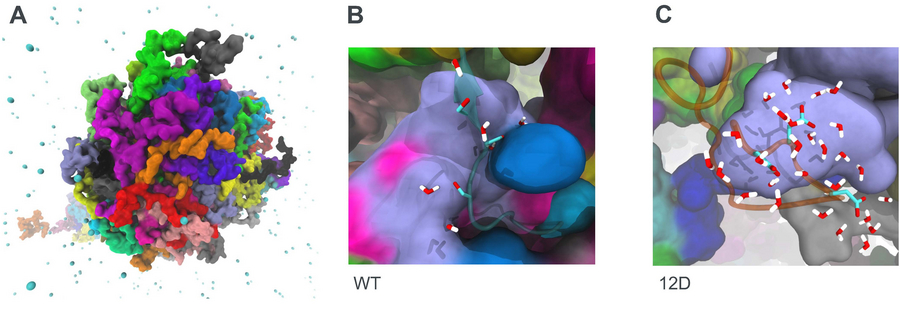Stelzl Lab
Research Publications Group Members BiographyMolecular principles that regulate gene expression by liquid-liquid phase separation

The discovery that liquid-liquid phase separation and phase-separated condensates of proteins and nucleic acids are important regulators in cells is revolutionising our understanding of cell biology. Liquid-liquid phase separation of biomolecules is analogous to the demixing of oil and vinegar in a vinaigrette. Through liquid-liquid phase separation, biomolecules can form distinct liquid phases - a dilute phase and protein- and nucleic acid-rich phase. Phase separation helps to organise biological functions in time and space. Thus, phase separation not only plays an important role in regulating genes at the transcriptional level, but also at the post-transcriptional level in developmental biology. Dysregulation of liquid-liquid phase separation is thought to be an important driver of ageing and age-related diseases (Alberti and Hyman, BioEssays, 2016).
Our aim is to understand how liquid-liquid phase separation provides precise regulation of biology and how it is dysregulated in ageing and disease using multi-scale simulations. Weak and multivalent interactions among disordered proteins and nucleic acids underpin and drive liquid-liquid phase separation. However, it is not understood how specific molecular recognition is achieved by these interactions, i.e. how do seemingly featureless molecules provide specificity? And how do mutations and post-translational modifications shape these interactions? We directly address these questions by using multi-scale simulations as a ‘computational microscope’. Molecular simulations have now progressed to a level where they can be used to complement experiments, aid interpretation of experimental data (Stelzl et al., J. Am Chem. Soc., 2017) and reveal biochemical mechanisms at atomic resolution (Stelzl, et al., eLife, 2020). In particular, multi-scale simulations can be used to model the long time and length scales required for biological self-assembly and phase separation (Benayad, et al, J. Chem. Theory Comput., 2021) while at the same time providing information at high atomic-level resolution (Pietrek, et al., J. Chem. Theory Comput., 2020). Such atomic-resolution information and atomistic description is often required to accurately capture the effect of mutations and post-translational modifications. Ultimately, with multi-scale simulations we can discover new biological connections, e.g. by identifying new interaction partners and helping guide experiments.

Regulation of gene transcription by liquid-liquid phase separation in health & age-related disease
Liquid-liquid phase separation and biomolecular condensates help regulate gene transcription in time and space and are thus critical in health and disease. Aberrant phase separation may switch on genes in age-related diseases and ageing. Post-translational modifications are critical for providing specificity in assembling biomolecular condensates and for specific molecular recognition of binding partners in phase-separated condensates. Non-cognate post-translational modification patterns may thus dysregulate phase separation and subsequently transcription. Mutations in disordered regions of a transcription factor, for example, may also lead to aberrant phase separation and erroneously switch on transcription in age-related diseases such as cancer. Using multi-scale simulations, we elucidate the molecular principles of regulation by phase separation and characterise potential molecular vulnerabilities of transcriptional regulation by liquid-liquid phase separation in ageing and disease.
Post-transcriptional regulation by liquid-liquid phase separation in developmental biology
Post-transcriptional regulation of gene expression by liquid-liquid phase separation and biomolecular condensates plays an important role in developmental biology. Using multi-scale simulations, we want to understand how liquid-liquid phase separation contributes to robust regulation in developmental biology. The Ketting group has shown that post-transcriptional regulation of gene expression by biomolecular condensates is critical in the development of germ cells (Roovers et al., Dev. Cell, 2018), which go on to form eggs and sperm. In their paper, they showed that an interaction between the disordered protein Buc and the multi Tudor domain protein Tdrd6a is important for the assembly of condensates via liquid-liquid phase separation during germ cell development. The condensates bind mRNAs to form messenger ribonucleoproteins (mRNPs), which are critical for germ cell development. During assembly, the mRNPs self-associate. With multi-scale simulations, we can understand how Buc and Tdrd6a interact at a molecular scale and improve our understanding of how their self-assembly and phase behaviour shapes germ cell development. In particular, we want to understand how interactions at the molecular level impact cellular regulation at larger scales and how such interactions may lead to robust regulation.
Development of multi-scale simulation methods & integration of experiments & simulations
Our group is contributing to the continuous development of multi-scale simulation methods for flexible and disordered biomolecules and liquid-liquid phase separation. Specifically, we are developing multi-scale methods to accurately capture molecular interactions in phase-separated biomolecular condensates. In addition, we use Markov-state models (Stelzl and Hummer, J. Chem. Theory Comput., 2017, Stelzl et al., J. Chem. Theory Comput., 2017) to characterise the association of disordered proteins and the assemblies they form. Furthermore, we are using Bayesian methods to rigorously integrate simulations with experimental data to create integrative models of disordered biomolecules. Integrative modelling will become increasingly important as more data becomes available and we want to understand more complex biological systems.